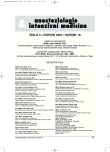Altering the hemodynamics during abdominal aortic aneurysm repair by acute normovolemic hemodilution
Authors:
J. Mannová 1; Z. Šilhart 2; P. Ševčík 1
Authors‘ workplace:
Klinika anesteziologie, resuscitace a intenzivní medicíny MU v Brně a Fakultní nemocnice Brno
1; Chirurgická klinika MU v Brně a Fakultní nemocnice Brno
2
Published in:
Anest. intenziv. Med., 18, 2007, č. 3, s. 141-149
Category:
Anaesthesiology - Original Paper
Overview
Objective:
To test the hypothesis that patients with acute normovolaemic haemodilution (ANH) tolerate better aortic clamping and declamping during abdominal aortic aneurysm (AAA) repair. Perioperative haemodynamic changes are mitigated, thus the frequency of ischaemic events and cardiovascular complications are decreased in comparison with the group of patients without ANH.
Design:
Prospective randomized study.
Setting:
Department of Anesthesiology, Resuscitation and Intensive Medicine, University Hospital.
Materials and methods:
50 patients admitted for elective AAA repair were prospectively randomized into two groups: patients in group A (n = 25) were treated with ANH and patients in group B (n = 25) were not. We monitored the following parameters: BP, MAP, HR, SV, CO, CI, TSVR (HemoSonicTM100, 400 measurements), troponin I level, transfusion requirements and 30-day mortality. Statistical analysis was made using Wilcoxon’s rank sum test, Mann-Whitney test and Fisher test.
Results:
After aortic clamping a statistically significant increase in the systolic BP and TSVR, and a decrease in SV, CO and CI occurred in both groups (p < 0.05). After aortic declamping, a statistically significant decrease in TSVR and the systolic, diastolic and mean BP, and an increase in SV, CO, CI were seen in both groups (p < 0.05). A statistically significant difference between the two groups was evident in CI after aortic clamping and the systolic and mean BP before declamping. Ischaemic myocardial injury was seen 6 times in patients with ANH vs. 8 times in patients without ANH. A statistically significant difference was not manifested.
Conclusion:
We did not demonstrate a statistically significant difference in haemodynamic changes, the frequency of perioperative or postoperative complications, and ischaemic events between two groups of patients treated with and without ANH.
Key words:
abdominal aortic aneurysm – acute normovolaemic haemodilution – haemodynamic parameters – transesophageal doppler – troponin I
Labels
Anaesthesiology, Resuscitation and Inten Intensive Care MedicineArticle was published in
Anaesthesiology and Intensive Care Medicine

2007 Issue 3
Most read in this issue
- Helium and its role in current medicine
- The evolution of airway management
- Altering the hemodynamics during abdominal aortic aneurysm repair by acute normovolemic hemodilution
- Early resuscitation of septic shock to different levels of arterial blood pressure
